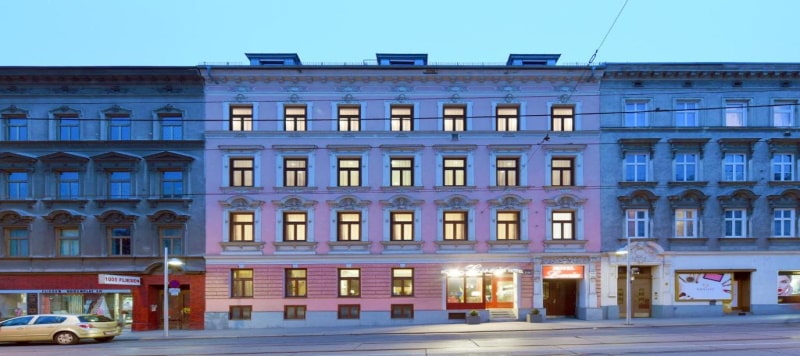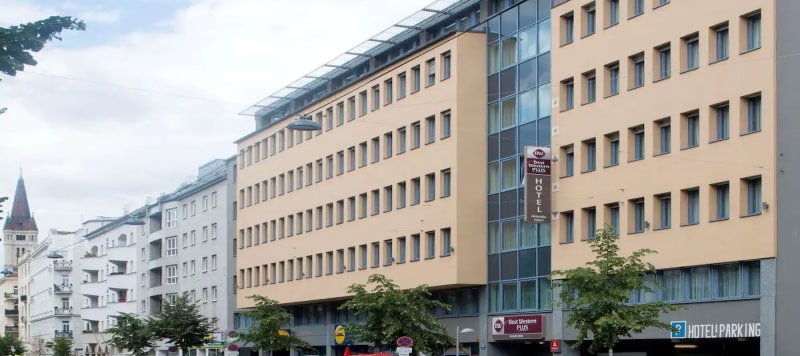
Vienna is a city bursting with culture, classical music, and a mixture of modernity and historic charm. The trendy Austrian capital is best known for its coffeehouses which have been an important part of its cultural heritage for several centuries. Many of the city’s remaining coffeehouses have been around for hundreds of years, offering delicious Viennese coffee and signature sweet treats including the famed sachertorte.
There are plenty of architectural wonders to explore and admire in Vienna including former royal residences, baroque style structures, and UNESCO World Heritage Sites. The city also boasts boundless museums and galleries, showcasing artworks by famous artists including Gustav Klimt and Pieter Bruegel, and there are plenty of lush parks and garden to retreat to after a busy morning sightseeing.
Vienna comes alive in the festive months with its famed Christmas markets that fill the city’s shopping streets and squares.

Hütteldorfer Str. 79, 1150 Wien, Austria

Landstraßer Hauptstraße 155, 1030 Wien, Austria
Vienna is a well-connected city with an efficient and affordable public transportation network that includes buses, trams, the metro (U-Bahn), and trains (S-Bahn). Tickets are valid across all these modes and can be used for multiple trips. Metro is the fastest way to travel across the city. Trains run frequently and cover major tourist spots and districts. Vienna's extensive tram network offers scenic routes, especially through the historic city centre. Buses cover areas not reachable by the U-Bahn or tram and run regularly.
Vienna is a bike-friendly city with plenty of cycling paths. The city is also very walkable, especially in the central districts. The city centre (Innere Stadt) is compact and ideal for sightseeing on foot. Taxis are widely available and can be hailed from the street or booked via apps like mytaxi.
Vienna is generally considered as one of the safest cities in the world, with a low crime rate and a strong sense of public security. However, like in any major city, it's important to stay cautious and aware of your surroundings. Petty crimes like pickpocketing are the most common, especially in tourist areas or on public transport. Watch out for your belongings in crowded areas, such as at Stephansplatz, Naschmarkt, or on trams, buses, and U-Bahn stations. Keep wallets, phones, and passports secure, especially during busy times.
Vienna has a rich culinary tradition with dishes influenced by its imperial past and neighbouring countries. Must-try local Viennese dishes and specialties include Wiener Schnitzel – a breaded, deep-fried veal/pork cutlet, Tafelspitz - a boiled beef dish, typically served with root vegetables, potatoes, and apple-horseradish sauce, Apfelstrudel (Apple Strudel) - A beloved dessert made of paper-thin layers of dough filled with spiced apples, raisins, and cinnamon, and Sacher torte - this iconic Viennese chocolate cake is layered with apricot jam and coated with dark chocolate glaze.
Viennale (Vienna International Film Festival) - taking place in October, the Viennale is Austria’s premier international film festival, featuring an eclectic mix of independent films, documentaries, and retrospectives from around the world at various cinemas across Vienna, including the historic Gartenbaukino and Stadtkino.
Donauinselfest - this free, open-air music festival is held on Danube Island (Donauinsel) every June, featuring international artists and local talent. It's Europe’s largest free open-air music festival, attracting over 3 million visitors with a wide range of musical genres, from pop and rock to electronic, indie, and folk music, spread across multiple stages along the Danube Island.
Christkindlmarkt (Vienna Christmas Markets) - Vienna’s Christmas markets are among the most famous in Europe, open between mid-November and end of December. The Christkindlmarkt at Rathausplatz is the largest, offering wooden stalls with handmade gifts, festive foods like Lebkuchen (gingerbread), and warm Glühwein (mulled wine). Smaller markets like those at Schönbrunn Palace and Belvedere Palace offer a more romantic, historic ambiance.
Lange Nacht der Museen (Long Night of Museums) - during the Lange Nacht der Museen in October, over 100 museums in Vienna open their doors late into the night, offering special exhibitions, guided tours, and workshops. It’s a great opportunity to explore Vienna’s incredible art collections and museums after hours.
Schönbrunn Palace - this UNESCO World Heritage site is the former summer residence of the Habsburgs, featuring baroque architecture and beautifully landscaped gardens. Explore the grand Hall of Mirrors, visit the Gloriette for panoramic views, and don’t miss Schönbrunn Zoo, the oldest zoo in the world.
St. Stephen’s Cathedral (Stephansdom) - this iconic Gothic cathedral is in the heart of Vienna. Its distinctive multi-coloured roof and tall spire make it a symbol of the city. Climb the South Tower for breathtaking views and explore the catacombs beneath the cathedral.
Belvedere Palace Vienna – a stunning baroque palace complex consisting of the Upper and Lower Belvedere, home to an impressive collection of Austrian art, including works by Gustav Klimt. Stroll through the beautiful gardens and enjoy views of the city from the Upper Belvedere.
Hofburg Palace Vienna - the former imperial palace of the Habsburgs, the Hofburg is a vast complex housing museums, the Austrian National Library, and the official residence of the President of Austria. Explore the Imperial Apartments, visit the Sisi Museum to learn about Empress Elisabeth, and see the Spanish Riding School performances.
Vienna State Opera (Wiener Staatsoper) - one of the most prestigious opera houses in the world, known for its remarkable performances and stunning neo-Renaissance architecture.Take a guided tour of the building or attend a performance to experience the magnificent acoustics and artistry.
Karlskirche (St. Charles’s Church) - this baroque church, located near the Vienna Opera House, is famous for its stunning dome and twin towers. Visit the interior to see beautiful frescoes and take the elevator to the dome for a panoramic view of the city.
Naschmarkt - Vienna’s most popular market, offering a wide range of fresh produce, spices, and international cuisine. Sample local delicacies, shop for souvenirs, and enjoy lunch at one of the many food stalls or restaurants.
Hundertwasser House – this colourful apartment building is known for its unique architectural style and vibrant façade. While it’s a residential building, you can admire the exterior and visit the nearby Hundertwasser Village for shops and cafes.
Vienna City Hall (Rathaus) - an impressive Gothic building that serves as the city’s town hall, located at the northern end of the Ringstrasse. Take a guided tour to learn about its history, and if you visit during winter, enjoy the charming Christmas market in front of it.
Vienna Philharmonic Concerts - attend a performance by the world-renowned Vienna Philharmonic Orchestra at the Musikverein, known for its exceptional acoustics and elegant concert hall. The New Year’s Concert is especially famous, but regular concerts are held throughout the year.
Vienna experiences a temperate continental climate with four distinct seasons.
Spring (March to May)
Spring sees gradually warming temperatures ranging from 8°C to 20°C and blooming flowers. March can still be chilly, while May often brings pleasant, mild weather. Rain is possible, so it’s good to be prepared for some wet days.
Summer (June to August)
Summers are warm and can be quite humid, especially in July and August. Temperatures range from 18°C to 30°C, with occasional heatwaves pushing temperatures even higher. Thunderstorms are common in the afternoons.
Autumn (September to November)
Autumn in Vienna features cooler temperatures ranging from 8°C to 22°C in September, dropping to 2°C to 14°C by November, and beautiful autumn foliage. September can still be quite pleasant, but by November, the weather becomes chillier, and rain increases.
Winter (December to February)
Winters are cold, with temperatures ranging from -3°C to 5°C with occasional snowfall. December is festive with Christmas markets, and temperatures often hover around freezing. January is usually the coldest month.
© 2021 Brightsun Travel